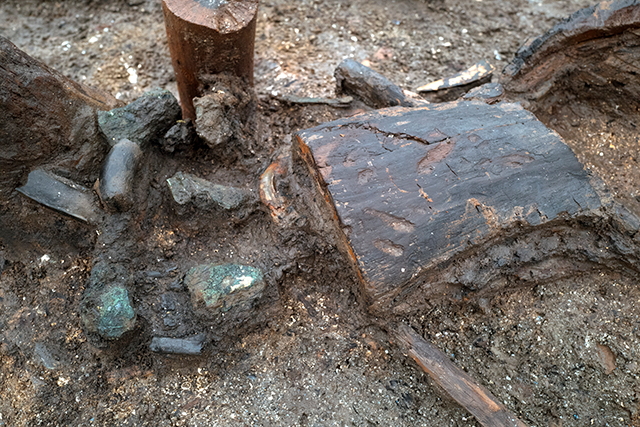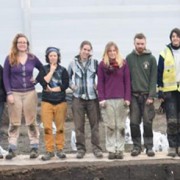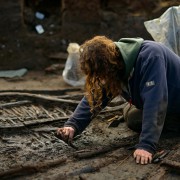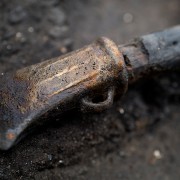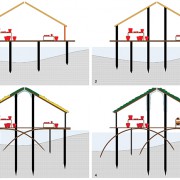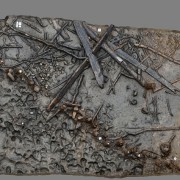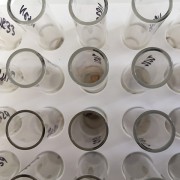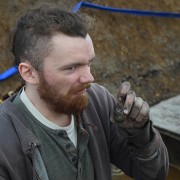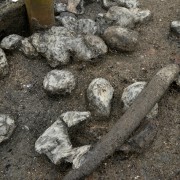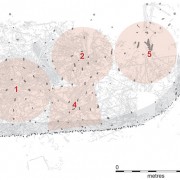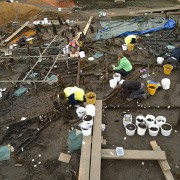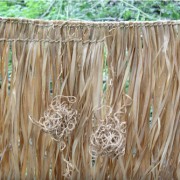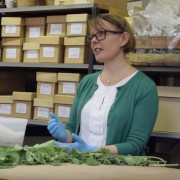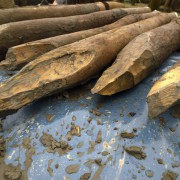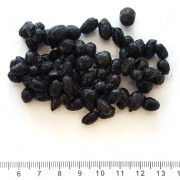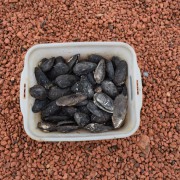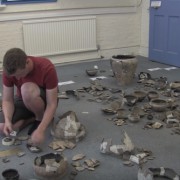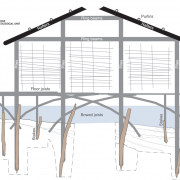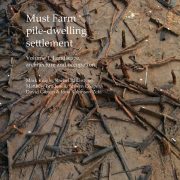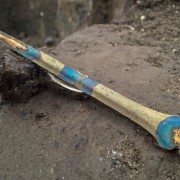Post Ex-Diary 15: Exploring Structure 4 Part Two
August 5, 2019
Structure 4: Entrance to the Settlement?
In our last Post-Ex Diary we discussed the difficulties of identifying and defining our only square structure at the Must Farm, Structure 4. During our recent analyses we’ve been uncovering more interesting details about this unusual building. Aside from its very different shape-in-plan, there are other distinct qualities about the structure and its contents that separate it from the other round dwellings found inside the settlement.
Structure 4 has strong architectural links to the palisade and it appears that it could have acted as a formal entrance or gate into the settlement. The position of Structure 4 and the palisade is against the edge of the river channel, over which the settlement was built. Could this “gatehouse” have acted as a way of getting from the firmer ground of the riverbank onto the raised pile-structures of the settlement?
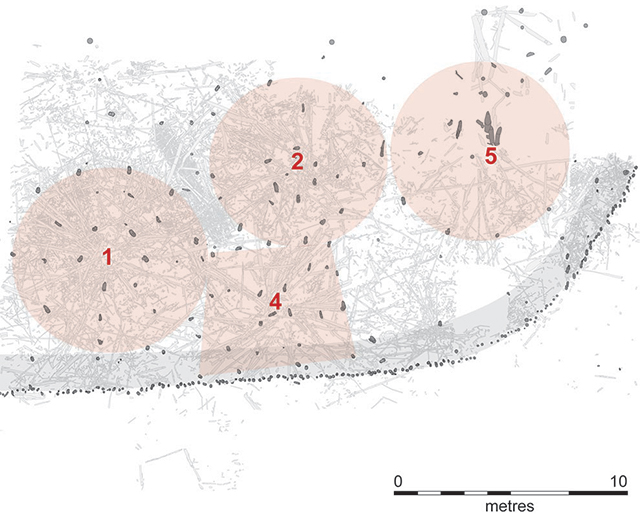
Close-up of a post-excavation plan showing the position of Structure 4. Note the proximity of Structures 1 and 2. Could people have moved easily around the settlement between structures?
The position of Structure 4 is also close to two of the raised dwellings, Structures 1 and 2. This proximity suggests that it could have been possible to enter these two pile-dwellings from Structure 4. These ideas of access have been making us carefully consider pathways between the dwellings, an issue we have been considering from very early in the excavation. Were the dwellings more connected and “open”, so people could walk from Structure 4 to Structure 2 and then pass through 2 to reach Structure 5?
These are difficult questions to answer as elevated architecture is much more difficult to understand in plan than structures found during dryland excavations. When encountering a roundhouse on a dryland site, its postholes typically reveal the location of entrances and features. However, tying vertical timbers and the partial remains of charred structural timbers with what they would have created is a far more complex undertaking which we are still working on. It may be that only with a greater appreciation of the fire which destroyed these structures and, crucially, what parts may be missing, that we can better understand all our structures’ architecture.
Structure 4 and its Material
During post-excavation we have been drawing together information on the different materials we recovered from the across the settlement. One of the most crucial elements to any excavation is understanding not only the nature of finds but the context of these materials. When we realised the very different character of Structure 4 we took a much closer look at the artefacts associated with this building. Very quickly, we realised that interesting patterns emerged that also suggested this structure could well be related to accessing the settlement.
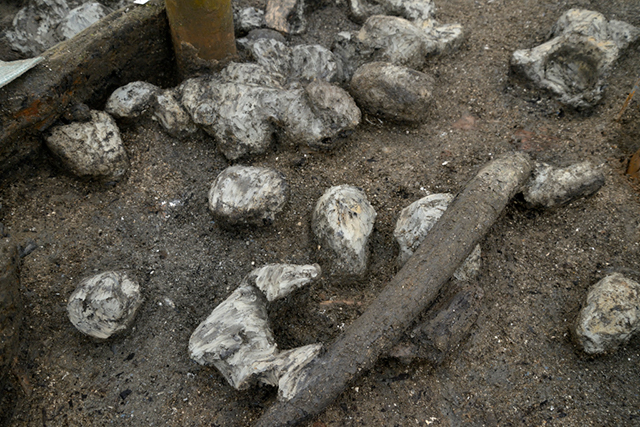
Photograph showing some of the “clods” of clay. Were these a raw material being stored in Structure 4 and waiting to be used in the settlement?
During the excavation we came across what could best be described as “clods” of clay that were very uniform but seemed out of place in a river channel. These mysterious lumps of clay did not seem to have been used structurally within any of the dwellings and caused a lot of speculation and confusion. Spatially the clay was associated with Structure 4 and further analysis has revealed that it is possible that the clods were blocks of raw material that had just been brought into the settlement and were waiting to be used.
Similarly, the beautiful stack of nested vessels was also found within Structure 4. Were these a set of new vessels that had just arrived at the settlement and were waiting to be incorporated into the houses? The character of much of the material tied to this structure seems different to the assemblages linked to the other dwellings. Was Structure 4 a form of gatehouse where material may have been temporarily stored when being taken into the settlement?
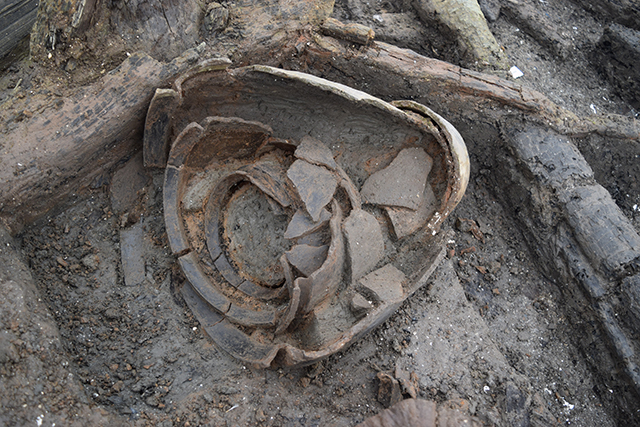
The stack of nested vessels found beneath Structure 4. Were these new additions waiting to be brought into one of the settlement’s dwellings
Interestingly, there is also evidence that some artefacts were being kept in Structure 4 before leaving the site. The Must Farm settlement’s sudden demise in a fire gave us the chance to catch glimpses of specific stories, many of which were tied to objects or groups of objects. One of these exciting moments was the discovery of a charred wooden bucket that contained many fragments of heavily-used or broken bronze artefacts.
At the time this grouping of metal and its clear relationship with a burnt container suggested that the bronze fragments had been collected together and stored, probably to be sent away, melted down and turned into new artefacts. This bucket of scrap metalwork would have been present in Structure 4 at the time of the fire and is likely to have been waiting to leave the settlement, again suggesting this building was a point of access for material going into, and out of, the site.
Other evidence also suggests a different character to Structure 4. There is a lack of items of personal adornment, such as beads, associated with the structure. We are still carrying out further analysis, exploring the positioning of artefacts and investigating the architecture of Structure 4 compared with the other circular pile-dwellings at Must Farm. Hopefully, we’ll be able to get a more fine-grained understanding of this more unusual structure, particularly its connection with the palisade and the other buildings.
The Palisade, Access and Further Questions
Other examples of gates, entranceways or “towers” are known from similar European Bronze Age settlements. Can the presence of a similar structure at Must Farm tell us anything about the settlement or its inhabitants?
The palisade surrounding the site was substantial and made from hundreds of posts driven into the edge of the river channel. It clearly was more than just a fence but was its function defensive? Could Structure 4 have been a single protected entrance to the settlement? We know that weapons are common from the Bronze Age and both spears and swords were present in the settlement. Equally, we know that the settlement was destroyed in a large fire, although there is little definitive evidence at this time for the blaze resulting from violence.
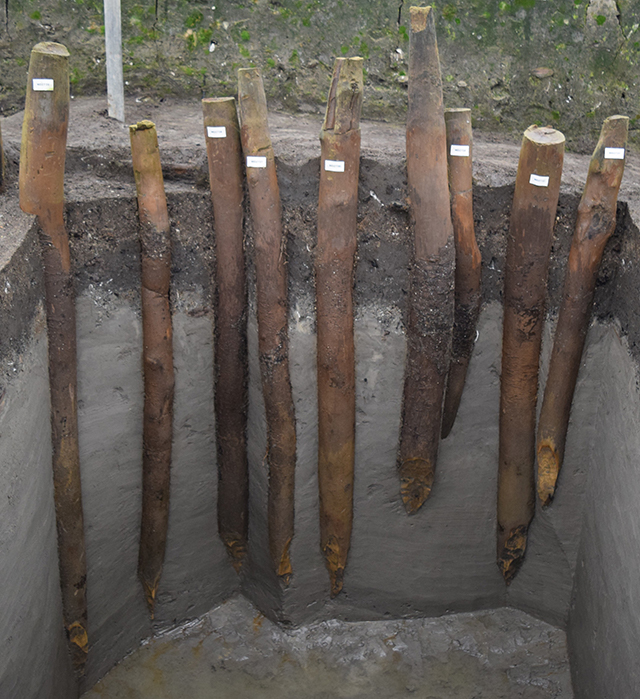
A section of the stakes that form the palisade. Was this meant to be defensive, to demonstrate the status of the settlement or both?
Alternatively, could Structure 4 represent an entrance that was designed to control access and the flow of goods and people into, and out of, the settlement? Could the palisade be designed to show the status or importance of the settlement and make an impression on people or communities that saw it? Owing to the presence of the earlier timber causeway and the presence of boats within the river channel, we know that the settlement was located at a routeway within the wider landscape. Could this settlement have been constructed to try and exert control or benefit from this routeway?
These are complex questions and we are currently trying to refine our evidence and gather further insight into the archaeology to see if our interpretations can address some of these issues. Since the excavation finished we are constantly discovering new aspects of the settlement, its structures and material. This continuous feeling of discovery and refining our interpretations and understanding helps to keep Must Farm so exciting and we are looking forward to bringing you more updates from our post-excavation next month.
Related stories
Post Ex-Diary 22: Working Towards Publication
May 11, 2020
Post Ex-Diary 21: The Importance of Visualisation – Photography Part Two
February 17, 2020
Post-Ex Diary 19: The Importance of Visualisation – Illustration
December 9, 2019
Post-Ex Diary 18: The Importance of Visualisation – Photogrammetry
November 11, 2019
Post-Ex Diary 17: Stable Isotope Analyses and Must Farm
October 7, 2019
Post Ex-Diary 16: Parasites and Lifestyles at Must Farm
September 3, 2019
Post Ex-Diary 15: Exploring Structure 4 Part Two
August 5, 2019
Post Ex-Diary 14: Exploring Structure 4 Part One
July 15, 2019
Post-Ex Diary 13: The Must Farm Pile-Dwelling Settlement Open Access Antiquity Article
June 12, 2019
Post-Ex Diary 11: The Must Farm Textiles Part One
April 1, 2019
Post-Ex Diary 10: Specialist Analyses Part Three
March 4, 2019
Post-Ex Diary 9: Specialist Analyses Part Two
February 4, 2019
Post-Ex Diary 8: Specialist Analyses Part One
January 7, 2019
Post-Ex Diary 7: The Must Farm Pottery Refit
November 5, 2018
Learn more
About
The Must Farm pile-dwelling settlement was excavated by the Cambridge Archaeological Unit with funding from Historic England and Forterra.Publications
Read the Open Access publications the Must Farm pile-dwelling settlement: Volume 1. Landscape, architecture and occupation and Volume 2. Specialist reports.Dig Diaries
The excavation of the Must Farm settlement was carried out between August 2015 and August 2016. Take a look at our diary entries documenting the excavation process. ...read more
Discoveries
See some of the discoveries from the Must Farm pile-dwelling settlement.
Making Must Farm
Find out about our work with AncientCraft recreating Must Farm’s material.
FAQs
Further information on the Must Farm project.

